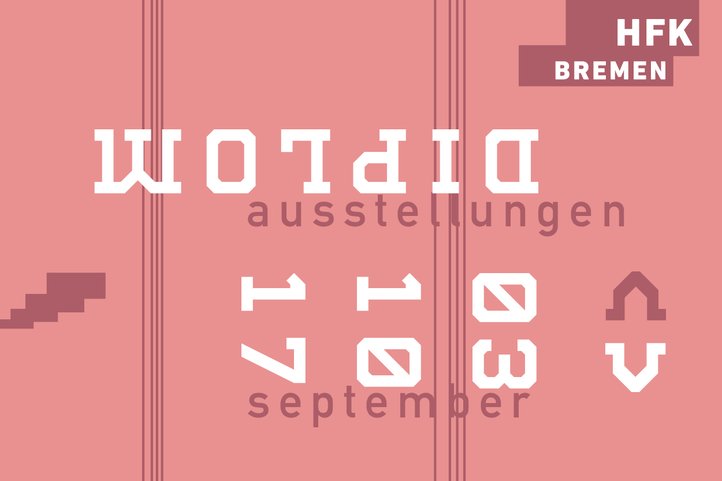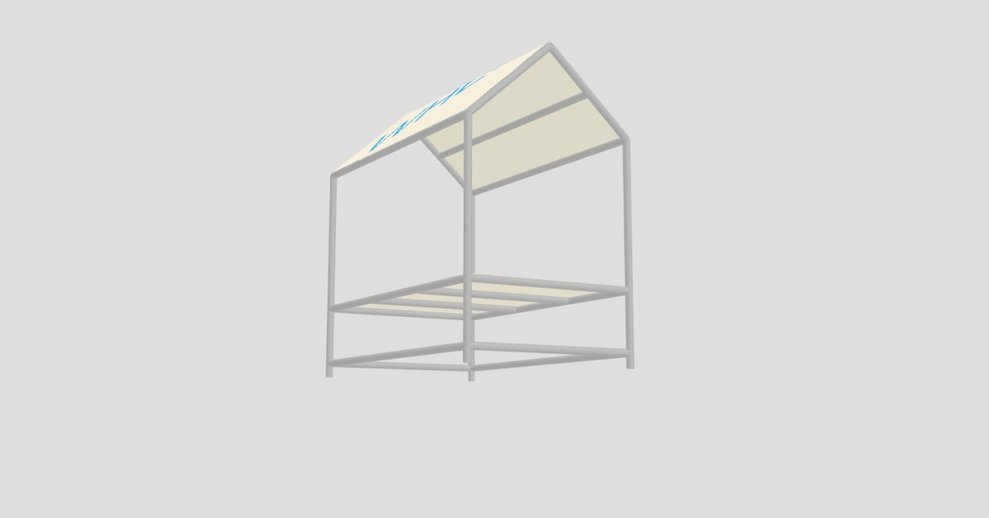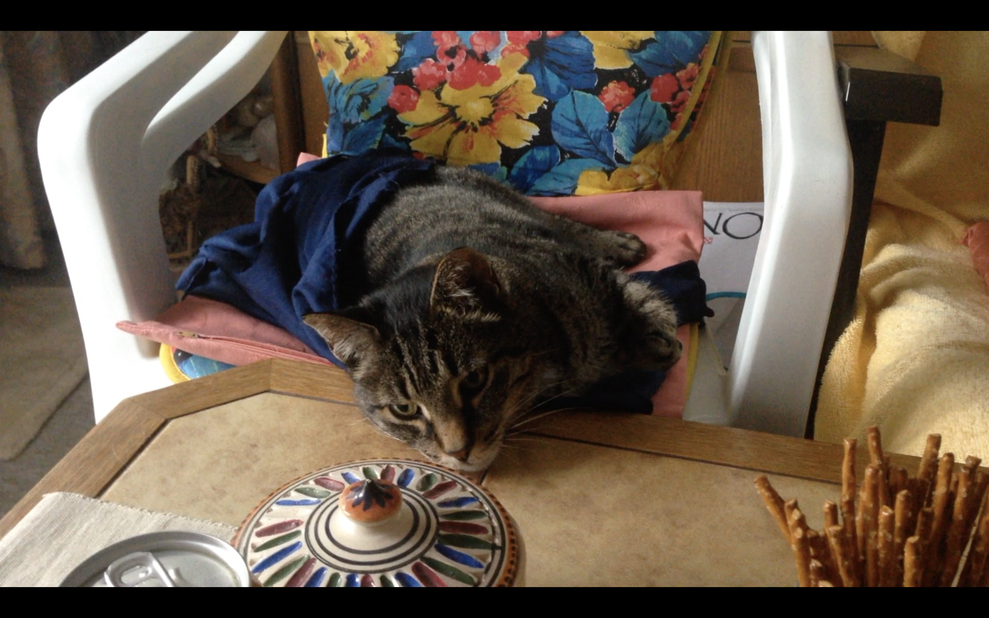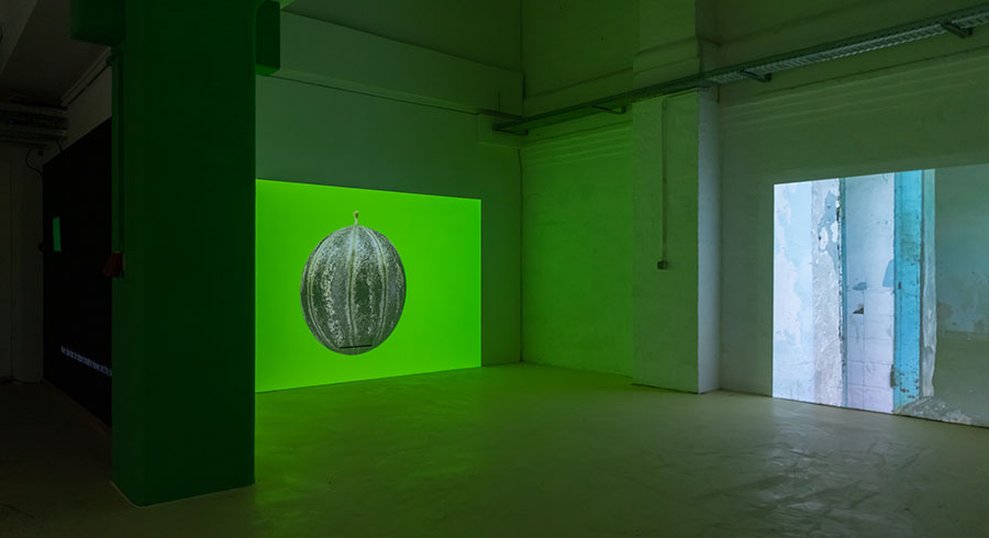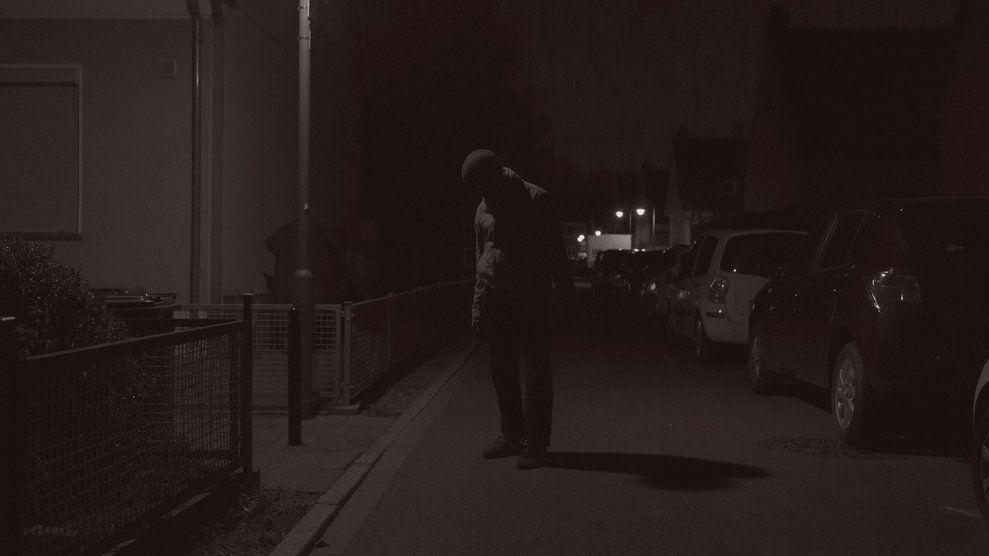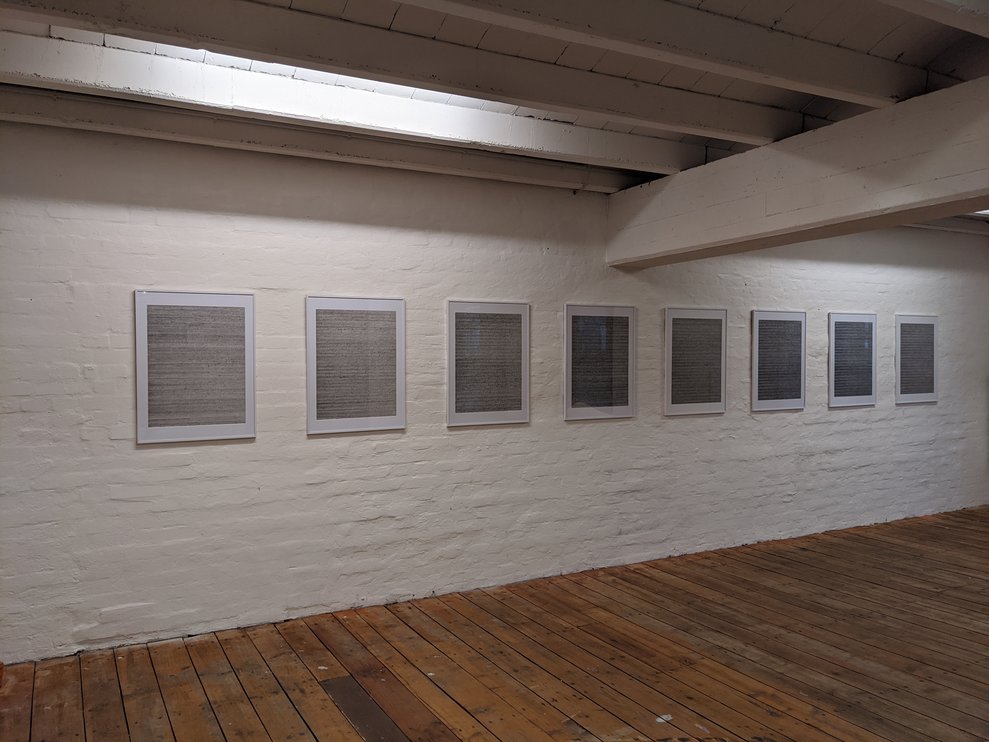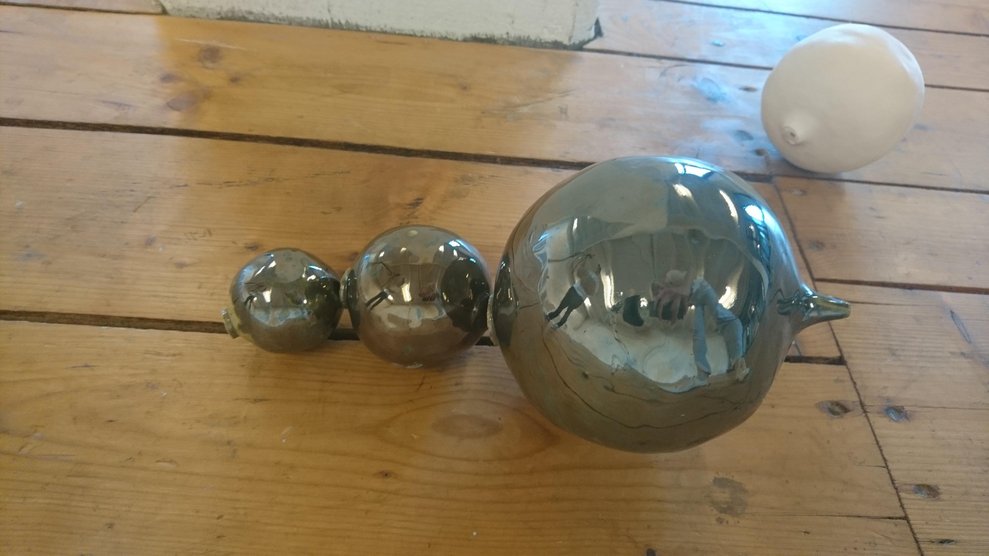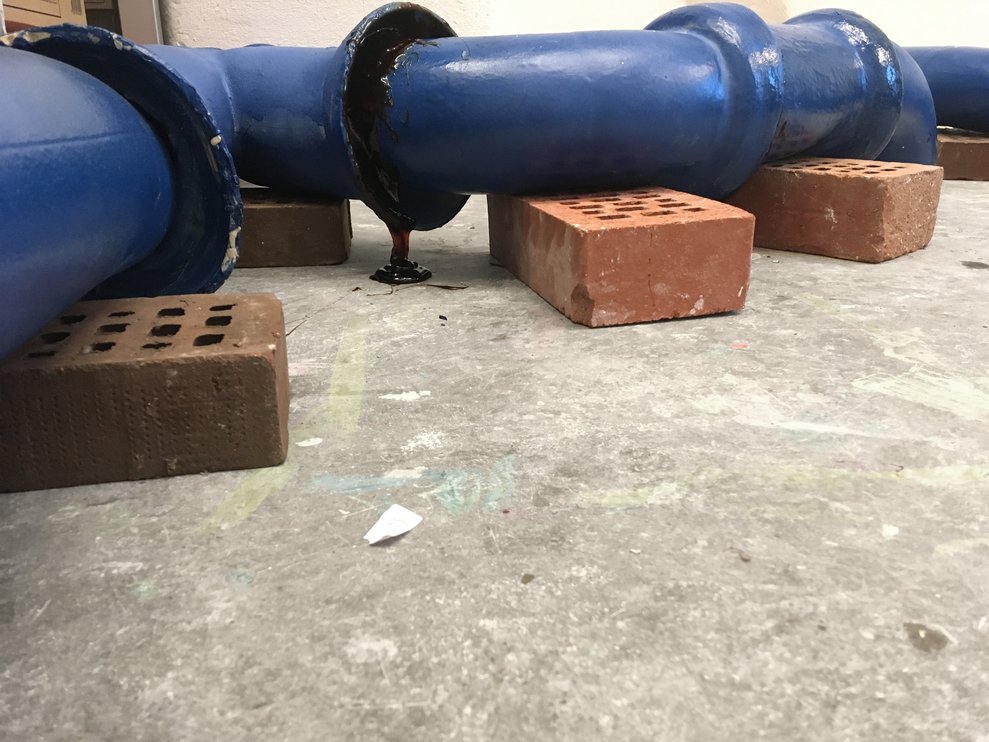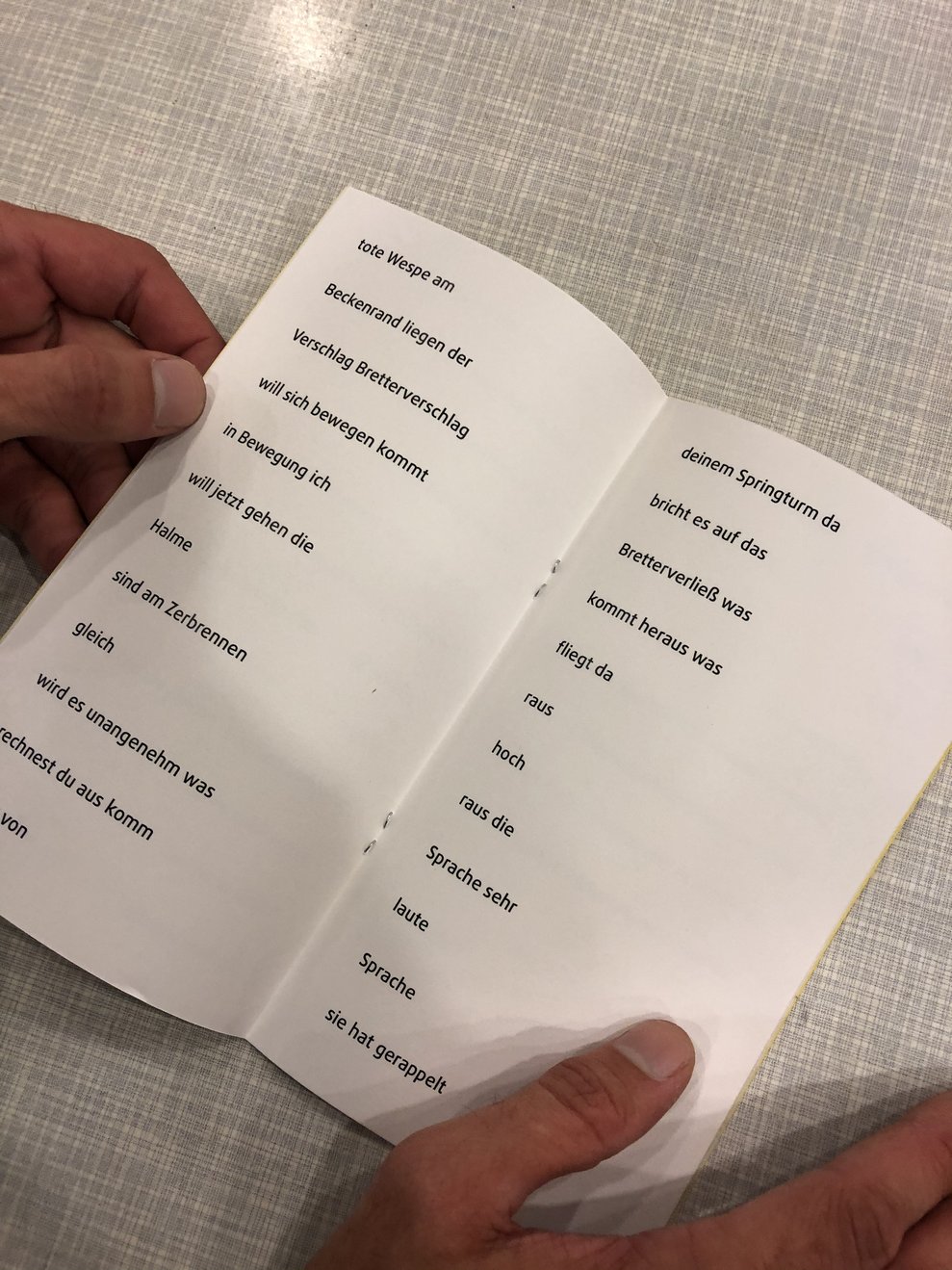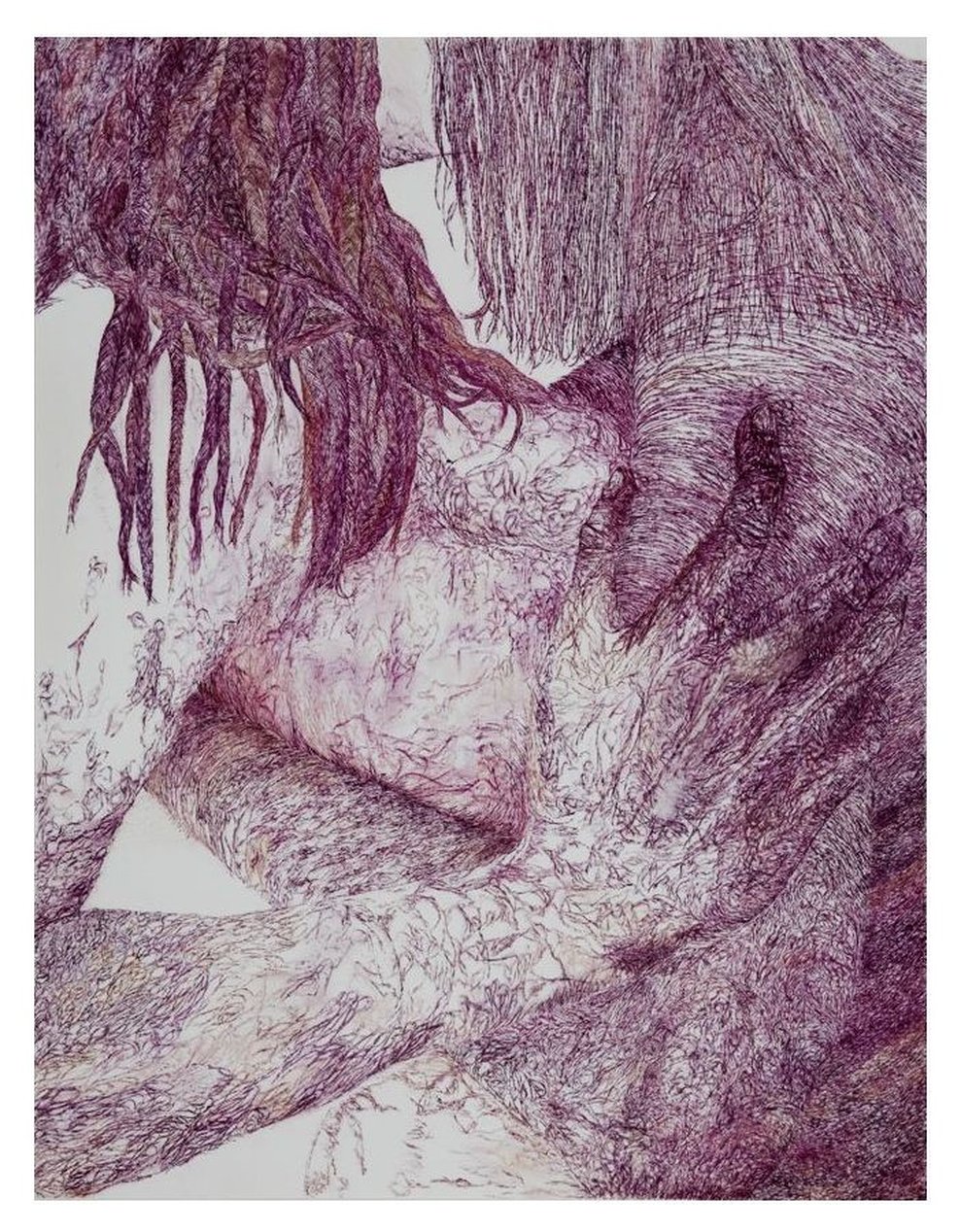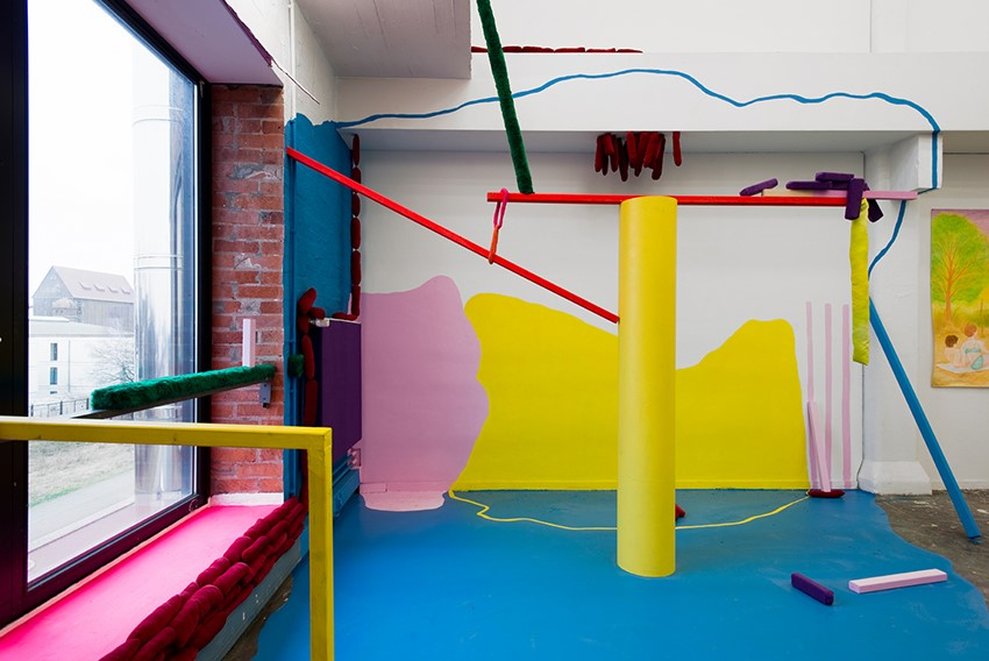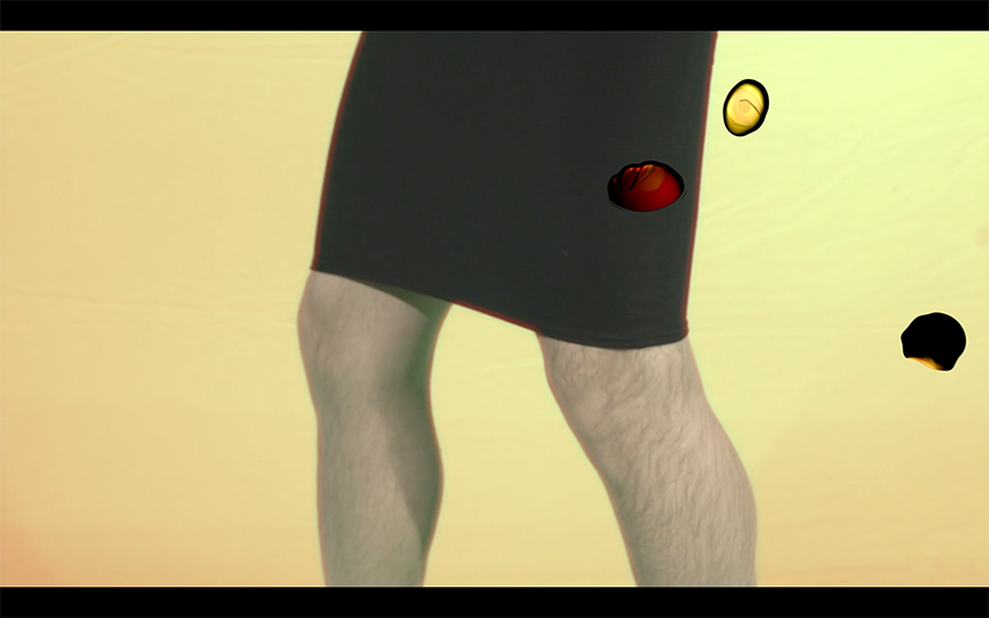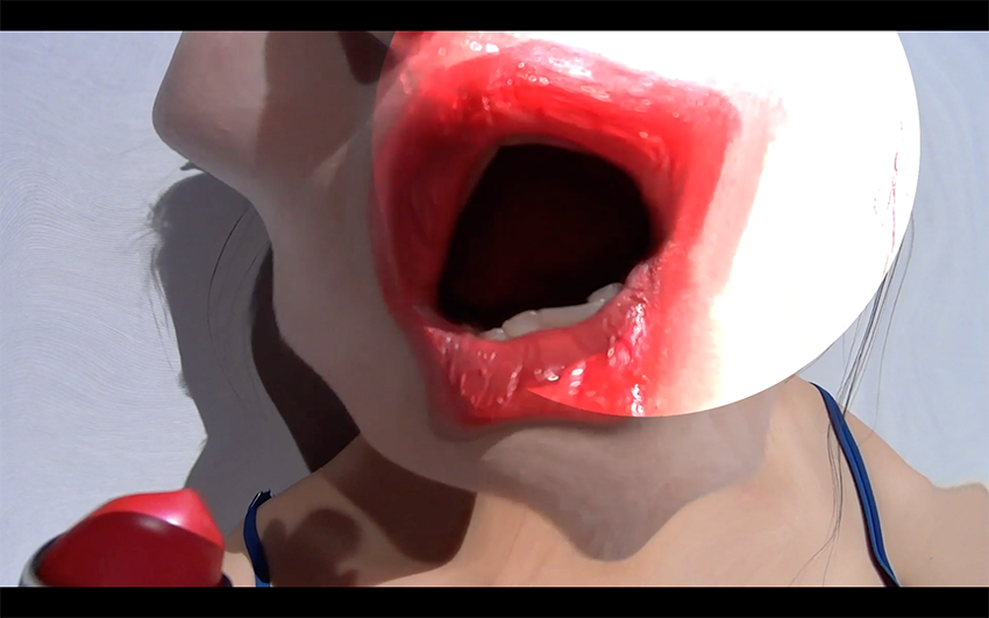From September 3rd to September 20th, graduates of the Fine Arts will be exhibiting their final works at various locations in Bremen as part of the 2020 diploma exhibitions. The works will be exhibited at different places and on different dates: on the Überseewiese in the open air, in the auditorium of the Speicher XI and in the gallery of the Dechanatstraße. Since the diploma exhibitions can unfortunately not be open to the public due to the current hygiene regulations, we will successively offer insights into the works - ranging from painting and drawing, installation and sculpture to film and performance - from September 3rd onwards.
Works in the Exhibitions from 3.9.–6.9.2020
About the work of Lucas Kalmus:
„Today, in a comprehensive crisis of global proportions in ecology, world economy and the psychology of the individual, it makes little sense to apply more and more layers in increasingly hectic gestures in order to hide the putrid core. Rather, one can use the opportunity to remember the basic principles that have made such an advanced and developed humanity with a social structure possible and at which point misunderstandings, miscommunication and ego problems of individuals have led to far-reaching diseases of civilization. My diploma project where revolves around the functions of public space, how it contributes to the perception of the world and to community building. The three scaffolding pavilions reflect and counteract the homogeneous spread of a 'European city' and the associated reproduction of a materialism that still has its roots in post-colonial relationships and patriarchal structures. The representation of exclusive wealth is just as important a point of reference in the work as the inclusiveness of the 'Urhütte'. Shelter, support, openness are structural properties of a Urhütte as well as abstract values of a feeling of home.“
About the work of Patrick Peljhan:
„VIVA VOCE
A short film by Patrick Peljhan
Year of publication: 2020
Duration: 20 minutes
Viva Voce (Latin for "oral tradition", viva "alive" and voce "voice") is still used today as a technical term in the fields of politics, law and academia, where it refers to oral votes, evidence or examinations.
In his short film "Viva Voce" Patrick Peljhan tells the migration history of his family and renegotiates the "collective contemporary history" interwoven with it. The starting point is the disintegration of Yugoslavia in the early 1990s and his first visit to his father's Croatian hometown shortly afterwards.
Using archive material from the Tagesschau, old VHS family recordings and more recent research footage, Peljhan speaks from offstage, alternating between free narrator and critical observer.“
Zur Arbeit von Shirin Mohammed:
„Title: A house then, a museum now: chapter one, wind of 120 days | multimedia installation | 2020
Installation shots by Jiye Lee
Shirin Mohammad presents a multi-media installation that immerses the viewer into a factory town that she investigated while researching areas of exile in Iran. This display was a preface to a research on the history of internal exile in Iran; a former Asbestos Industrial Complex was taken as a model of a city of exile. Different parts of the complex included accommodation for the workers and their families, accommodation for the managers, engineers and their families, a mosque, the main factory building and the asbestos mine at the foot of the mountain. It is located in a desert climate exposed to the Wind of 120 Days; today all factory grounds are deserted.“
Zur Arbeit von Sebastian Moske:
One Night in Klein Mexiko / Dear (2020)
Video-Installation in der Spedition beim Güterbahnhof
„Für seine Diplomarbeit über die Westphalensiedlung in Bremen, Hastedt arbeitete Sebastian Moske mit fünf Performer*innen vor Ort und über's Telefon/Internet während des Lockdowns, wobei der inoffizielle Name der Siedlung »Klein Mexiko« der Ausgang der Arbeit ist.
Billy the Kid, Ballroom-Culture, Männerphantasien und Sozialbau der 20er Jahre in Bremen sind narrative Bausteine der gemeinsamen Improvisationen.
Sebastian Moske studierte von 2006-2010 an der Hochschule für Musik und Theater in Hamburg Schauspiel, arbeitete im Festengagement am Theater und ist seit 2014 Teil der Klasse »Erweiterte Ideen von filmischen Räumen und konzeptuelle Fotografie« von Rosa Barba (HfK Bremen).
In seinen Arbeiten untersucht er im Dialog mit Performern, bildenden Künstlern und Musikern Literatur und Story-telling auf seine Möglichkeiten zwischen Berührung, Flirt, Verführung und der Gewalt von Übersetzungen.“
About the work of Ul Seo:
„‘What to think’ and ‘What to do’ are common pressures in Korean
society. Most of these forces are focused on being worthy economically
or established in society. And they are being kept under control through
media, education and lifestyle.
Also, being exposed to this pressure
for a long period of time, people are thinking they are leading their
life under the illusion of living a valuable life.
Through these
repeated pressures, at some point people live like a machine or a
component for the purpose and value desired in Korean society.
Life
in Germany is not much different. It continues unconsciously to be
subjected to this compulsion. And I am forced to repeat the question,
"Am I a valuable person in this society?" The framework of pressure
remains.
In the repetition of being under pressure I came to ask
myself at one point, whether the values that are communicated to me are
really my own values.
At the same time, I discovered the value of
repetitive actions and materials, not the value given by society, by
repeating invaluable, useless acts that are commonly used in Korean
society and completing the repeated actions at some point through my own
regulations.
What I realized by repeating the same behavior is that
there are countless processes of change in the small areas of everyday
life. I looked back on my work differently and discovered unexpected
things that I could not find at any moment before. The lines all seemed
the same for example, but if I change my attitude and look at them
slowly, they are all different sizes and different shapes. Through this,
I found that if the seemingly unworthy acts, time and materials are
accumulated and stacked, it has some different values as itself, which
is not given by society.“
About the work of Sabine Peter:
Sabine Peter (class of Prof. Wendelien van Oldenborgh) will be
presenting her final work as part of the of the diploma exhibitions
2020. Her work consists of different ceramic objects that describe the
attempt to disperse a voice. The objects also deal with all the detours
to which the material clay leads.
Works in the exhibition from 10.9.–13.9.2020
About the work of Tomma Köhler:
diploma exhibition „combined conclusions“
Bühnenraum 1 „they seemed to like it“ (not in the picture)
Bühnenraum 2 „einer ist hingefallen“
Bühnenraum 3 „Aktion“ (not in the picture)
Since 2014 I have been studying in the class for artistic space and body concepts, with Markus Löffler and André Korpys. My work combines my interest in performance, scenography and sculpture. One of my main focuses is the occupation with definitions. Sculpture, object, stage, space. Here the play with definitions is translated into a play of material. I work sculpturally with paper and metal. Video works are also part of my spatial installations in which I sketch scenes that include my involvement with society and its outsiders as well as my examination of space. The objects shown in the diploma exhibition partly function as characters, and partly open a space in the head of the viewer, which is transported into the exhibition space by other objects of the installation.
Zur Arbeit von Laura Pientka:
UBPCS_Ultimate Beneficial Pipeline System
Soundinstallation und Performance
„In der Galerie in der Dechanatstraße und in deren Außenbereich ist ein Rohrsystem aufgebaut, welches sich parasitär auf dem Boden ausbereitet und ebenso plötzlich verschwindet, wie es auftaucht. Das Rohrsystem besteht aus bis zu einem Meter langen Keramikrohren, insgesamt erstreckt sich eine über vierzehn Meter lange Installation. In dem System wird etwas transportiert, dass mit bloßem Auge nicht sichtbar ist. Durch die verlegten Rohre hallen lediglich Klänge. Diese laden zum Schmunzeln ein, denn sie klingen wie Darmwinde. Woher diese kommen und wohin sie gehen, bleibt offen.
Die Künstlerin ist durch ihre Performance aktiver Teil des Werkes. In minutiöser Arbeit hält sie die Rohrverbindungen mit einer klebrig fließenden Masse dicht. Die Prozedur des „Stopfens“ wird im Laufe des Tages ohne Rhythmus wiederholt. Es besteht ein Spannungsverhältnis zwischen dem von der Künstlerin getragenen, eher männlich konnotierten Blaumann und der fragilen Keramik, die oftmals einer Konnotation der „schönen“ und „weiblichen“ Handwerkskunst unterliegt.“
Zur Arbeit von armin Wischkony.
„sitze ich
zwischen den Platten ich
suche den Halm zwischen
mir
ist auch das Rattangeflecht
bekannt mir
ist alles Gewebe bekannt
ich will den Halm was
zieht den Kirchturm nach oben was
machst du da oben
springst du jetzt oder nicht ich
will mich abtrocknen mir
ist ein bisschen kalt ich
gurre nach dir
aus: Armin Wischkony, Brandweite, 2020
Lesung Brandweite
Rauminstallation, verschiedene Materialien
Audio Loop ca. 12 min.
2020“
Works in the exhibition from 17.9.–20.9.2020
Zur Arbeit von Chris Ghitulescu:
„Das Pressen vom Farbblut diverser Blütenblätter mittels Fingernagel in Papier, stellt seit ungefähr sieben Jahren das Zentrum meiner künstlerischen Praxis dar.
Mit der Wandinstallation und einzelnen Bilder strebe ich an, dies weiterzuentwickeln, indem ich meine Arbeit über die reine Performance des Zeichnens und fertige Zeichnung erweitere. Es gilt, das Potenzial des zugrundeliegenden Konzepts und dessen implizite, symbolische Materialität auch als installative Arbeit auszuschöpfen, als Installation neu zuschöpfen.
Die Rauminstallation (Stoff / Glas / Matratze) zielt darauf ab, Konzept und Material auf einer tieferen Ebene zu verbinden und atmosphärisch entsprechend zu verbinden. Es gilt, das Momenthafte durch die Beleuchtung zu betonen und mit dem statischen und doch leichten Aufbau der schweren Glasobjekte und schweren Matratze auszubalancieren ohne die Ambiguität und Ambivalenz der Material und Bedeutungsebene zu brechen.“
Zur Arbeit von Charline Zongos:
„In meiner Arbeit übertrage ich Malerei, durch das Arbeiten mit Stoffen und Lack auf Materialien wie Holz, Stahl, Schaumstoff, Folie oder auch Watte, sowie auf Böden und Wände.
Dadurch entsteht eine dreidimensionale Malerei im Raum, die begehbar ist und den Betrachter*innen die Möglichkeit bietet, sie von allen Seiten erfahren zu können.
Meine Inspirationsquellen haben dabei meist einen unerwarteten Ursprung und lassen freie Assoziationen zu. Aus diesen resultieren einzelne statische oder auch fragile Werke, die einen Bezug zum Raum und untereinander haben. Auch sehe ich meine Arbeit als lebenden Organismus, der gepflegt werden und sich entwickeln möchte.
Es gibt somit keinen fertigen beschränkten Zustand oder eine gelöste Zusammensetzung. Das Werk kann sich während einer Ausstellung verändern. Der Organismus soll wachsen, sich wiederholen, vom Raum Besitz ergreifen, ihn sich zu eigen machen, sich selbst überlagern, umhüllen, verdichten und selbst zum Raum werden.“
Zur Arbeit von Paul Ole Janns:
„Einflüsse altmeisterlicher Malerei werden verwoben mit Comic und Graffiti. Ich benutze Sprühfarbe, Acryl-und Ölfarbe auf Leinwand. Die Motive sind mein alltäglich Erlebtes. Durch Perspektivenspiel, übersteigerte Darstellung und eine intensive Farbigkeit entstehen groteske und humorvolle Bildwelten.“
About the work of Ji Yoon Chung:
„I believe we are living in a world where our identities can shift around at any time. It is not fixed, it is fluid.
My works talk about these identities. Whether be it gender or any other attributes, I am aware of the power and the gaze that stick to me as I 'wear' certain identities.
I use my body as a tool, as a starting point to subvert the notions that are embedded inside cultures.“
